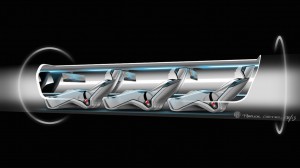
Elon Musk's Hyperloop is moving toward reality as he announced plans to build a five-mile test loop in Texas.
Now that the Detroit Auto Show is moving into the public showing phase, Tesla founder Elon Musk can focus on another project: the Hyperloop. In a series of tweets, he said he plans to build a five-mile test track in Texas to allow companies and student teams to use for testing.
In fact, the serial entrepreneur tweeted he’d like track to play host to a student competition similar to Formula SAE, where student teams form fictional companies and then design, build and test a Formula One-style race car.
The concept of the hyperloop is akin to what you’d see at bank drive-through lanes: put the container with your deposit into a tube and then a huge blast of compressed air moves it along into the bank.
Musk has described it as a cross between Concorde, a railgun and an air hockey table. Passengers sit in cars that are fired down the tube which had had most of its air removed. A system of magnets would accelerate and brake the capsules, and also keep them from touching the sides of the tube.
“Actually it would feel a lot like being in an airplane,” Musk said during a conference call. “There would be initial acceleration and once you were travelling at speed you wouldn’t notice the speed at all.”
(Tesla won’t be profitable until 2020. Click Here for more about the company’s future.)
In this case, he’s proposing the Hyperloop as an alternative to a high-speed rail line linking Los Angeles and San Francisco. According to Musk, the Hyperloop would be faster – moving passengers back and forth in less than 30 minutes – and significantly cheaper.
(Click Here for details about Elon’s Musk’s Hyperloop.)
Musk believes the loop could be built for $6 billion while the high-speed line is estimated at $70 billion although Musk said he thinks it will end up costing $100 million.
(To see more about Local Motors’ plans to build two 3D micro-plants, Click Here.)
However, he’s also trying to avoid using his $6 billion to build it saying he’d rather let others handle it, but “I do want to see it come to fruition.” The upside is that he already has some outside interest.
A crowd-funded California-based project named Hyperloop Transportation Technologies has started work on how it could be constructed, although they don’t have working prototype. There are about 100 engineers across the U.S. working on the development of the system, but they are at least 10 years away from a successful system.

When Costco first open it’s shop in Mountain View in 1995/96, I walked in and fascinated by the cash transfer tube between the cashier and the back office may be 30/40 feet away. The vacuum suction theory is basically very simple, at that time I was thinking if we have a tube across the Pacific ocean then we can link up US and Asia; we can have lunch in HongKong and be back for dinner in San Francisco.
AFAIK it’s a vacuum system not a compressed air system. I suppose if they have a leakage issues they could use compressed air as a supplement.
I’m not buying what Musk is selling today as I just don’t see it as viable for a long distant device. In addition in the real world you’d have to have air in the compartments for passengers to breathe and you’d have to have escape areas all along the line in the event of the passenger device getting stuck. I doubt they’d want to get out chain saws and start cutting up a plastic tube or cutting torches for a steel tube to get stuck passengers out of the tube before they died.